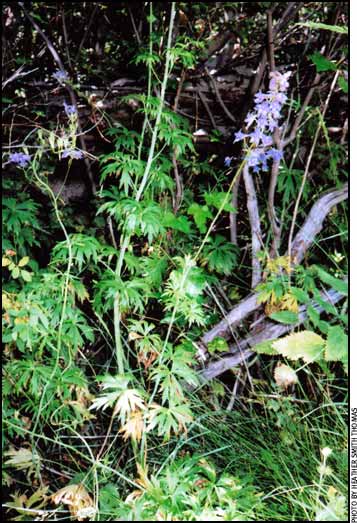Plants that Harm Cattle
Monitor pastures for occurrence of poisonous plants
and cattle grazing behavior.
There are many plants that can cause illness, death, abortion, metabolic disorders and other problems in cattle. Death loss from consumption of poisonous plants varies annually (USDA estimates average loss between 3% and 5%), but there are other economic losses as well, such as poor rate of gain or reproductive losses from toxic effects.

Some plants contain substances directly poisonous to livestock, such as the alkaloids found in larkspur.
Many plants are classified as poisonous, but some vary greatly in toxicity, depending on the conditions in which they grow or when they are eaten. Some make good feed in small amounts or in certain seasons, but are poisonous in different situations.
Some plants contain substances directly poisonous to livestock, such as the alkaloids in lupines and larkspur. Others contain elements that are harmless until they become chemically changed by freezing or enzyme activity, such as the glycosides in chokecherry leaves, which become deadly cyanide. Some plants absorb substances from the soil and accumulate these to toxic levels, such as selenium in locoweed and other milkvetches.
Poisoning often depends on several factors, including palatability (some plants are readily eaten; others are avoided unless good feed is in short supply), stage of development, conditions in which they grew (some species of saltbush are good forage except when grown in soils high in selenium), moisture content of the plant, or the portion eaten (some have more poison in the roots, seeds, or some other part). Plant poisoning can be suspected if cattle are moved to new pasture or fed different hay and experience sudden onset of illness or deaths.
Since many poisonous plants cause death quickly, treatment may be useless; the animal is often dead when discovered. Find out which plants grow in your range pastures, fields and along fencelines and ditches, and how to avoid situations that may lead to poisoning. Different regions have different problems, and some plants may not pose a threat except under specific circumstances.
For instance, in western states death camus, hemlock, larkspur and locoweed are common problems, along with pine needle abortions. In the Midwest some of the most common poisonings are due to poison hemlock, brackenfern, cocklebur, horsetail and Johnsongrass. The latter can produce cyanide poisoning if grazed after a hard frost or after drought conditions that produce slower growth.
Poisonings in Texas are often due to milkweeds, locoweed, Texas buckeye, redroot pigweed, jimsonweed, low larkspur, and African rue (an exotic plant that spread onto rangelands in Arizona and Texas). Other states and climate areas will have a different set of plants and problems.
For more information about poinsonous plants, visit these web resources:
- http://www.ansci.cornell.edu/plants
- http://www.ars.usda.gov/Services/docs.htm?docid=12140
- http://extension.missouri.edu/p/g4970
- University of Arkansas bulletin

[Click here to go to the top of the page.]











